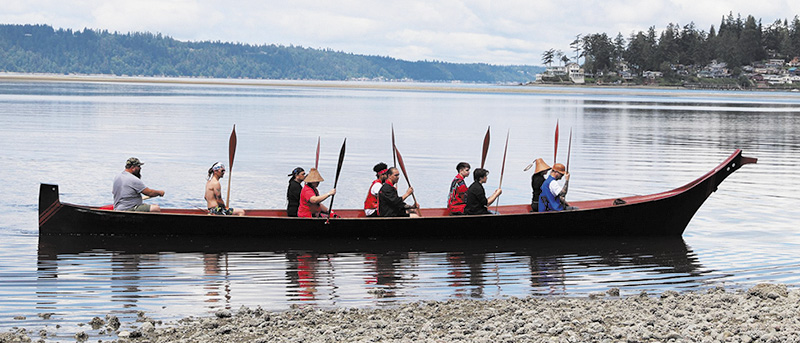
By Kalvin Valdillez, Tulalip News
“The reason Salmon Ceremony is important is because it’s a part of our culture,” said Tulalip tribal member, Josh Fryberg. “We want to preserve it for our future generations while honoring our past generations, who kept the ceremony alive for each and every one of us.”
On the bright and overcast morning of June 11, Tulalip dancers and singers gathered outside of the tribal longhouse. They shared laughter and exchanged many pleasantries while draped in traditional regalia. Cedar-woven hats, headbands, cuffs, waistbands, and jewelry were proudly displayed by the Coast Salish people, as were beautifully designed shawls, vests, ribbon skirts and shirts.

Meanwhile, the community gathered inside the longhouse, and joining them were several members from other tribal nations including Lummi, Swinomish, Quinault and Makah. There were also many non-tribal members in attendance, who wished to learn more about the traditional lifeways of the Tulalip people and witness the important work that is practiced at the start of every fishing season.
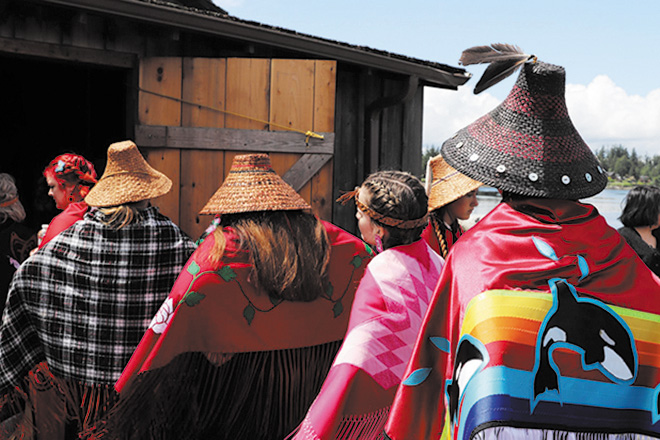
The drummers and singers formed a line beginning at the entrance of the cedar-plank building, and at 10:30 a.m. on the dot, they began to sing Harriette Shelton Dover’s Welcome song as they entered the longhouse, circling the fire at the center of the floor twice.
“This ceremony was taken away from us,’ said tribal member, Arielle Valencia. “It’s good that we’re reclaiming it.”
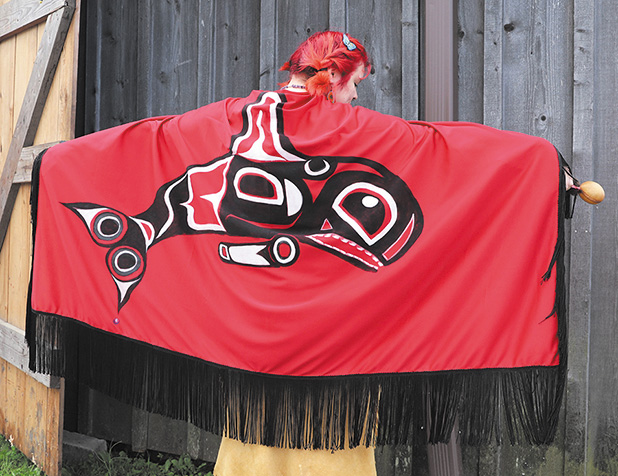
In an attempt to ‘kill the Indian, save the man’, the U.S. Government outlawed cultural and spiritual practices during the early 1900’s. The sduhubš ancestral teachings, language, and traditional way of life were almost completely lost, including the Salmon Ceremony. However, a resilient group of tribal members held onto their teachings while they also endured the horrific boarding school experience.
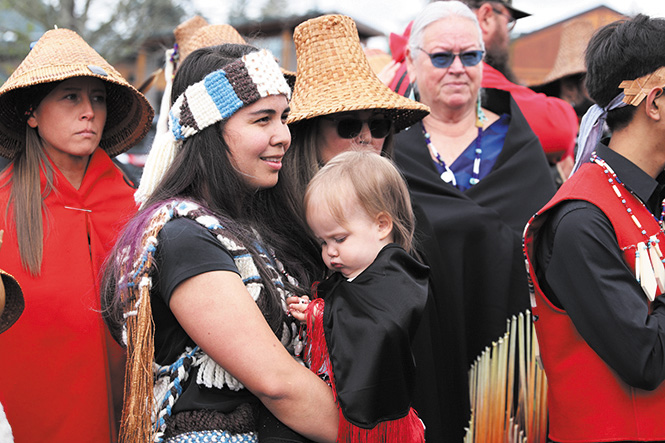
After years of keeping that information tucked away safe in their memory banks, they came together in the mid-70’s and recalled the events that took place at the Salmon Ceremony, sparking a revitalization that grows stronger with each passing year. Leading this revival was none other than Harriette Shelton Dover, who passed on the story of the Salmon People and a handful songs that are a major part of the annual ceremony of honor.
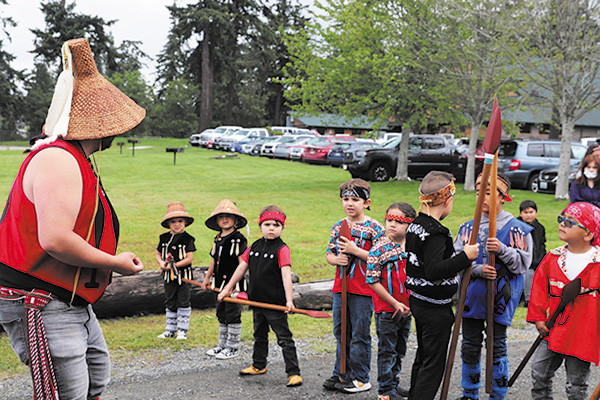
In the early 90’s, Tulalip Leader Bernie ‘Kai Kai’ Gobin shared a retelling of the Salmon People story with the Marysville School District. Kai Kai shared, “The story goes that there is a tribe of Salmon People that live under the sea. And each year, they send out scouts to visit their homeland. And the way that the Snohomish people recognize that it’s time for the salmon scouts to be returning to their area is when, in the spring, a butterfly comes out. And the first person to see that butterfly will run, as fast as they can, to tell our chiefs or headmen, or now they are called the chairman. One of the other ways they recognize that the salmon scouts are returning is when the wild spirea tree blooms. The people call it the ironwood tree, and that’s what they use for fish sticks and a lot of other important things, like halibut hooks. It’s a very hard wood. So, when they see either one of these, a tribal member will tell the chairman, and he immediately sends out word to the people and calls them together in the longhouse for a huge feast and celebration to give honor to the visitors that are coming.”
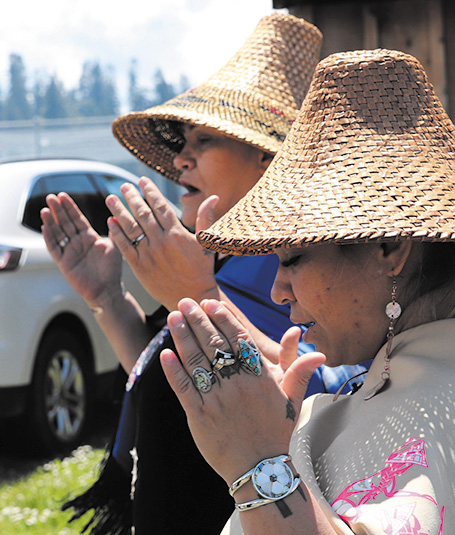
The current Chairwoman of the Tulalip Tribes, Teri Gobin, has a special connection to the Salmon Ceremony and has attended each gathering since it’s revival, as well as every practice leading to the event each year.
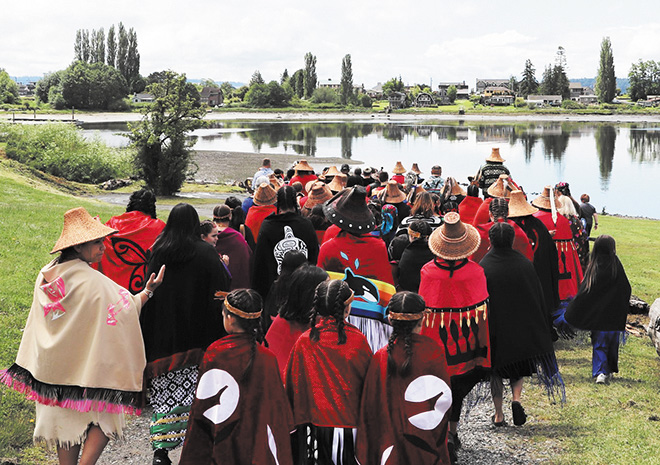
Teri shared, “My father [Stan Jones Sr.] was one of the main people to work with the elders to bring the Salmon Ceremony back. A lot of these songs were almost lost. It was Harriette Shelton Dover and all these iconic elders that wanted to make sure this was carried on. That was so important. My mom was the one who brought the cakes, and we would visit and write everything down to keep it for future generations. And that’s what’s most important, that these young ones are learning now.”
The future of Tulalip was well-represented at this year’s gathering. Youth of all ages took the ceremony very seriously, recognizing the importance of an event that pays tribute not only to the salmon, but to their identity as the descendants of the sduhubš people. Happy to engage in the cultural experience, each time the kids entered the longhouse they went in focused solely on the work that was taking place, and sang and danced with their all.
“It’s important that we understand and learn the songs that have been brought back by the elders, the main songs of the ceremony,” stated young tribal member, Image Enick. “The ceremony is also important because I’ve always thought of it as a good way for the young ones to learn the songs, and what it is to see and show respect. And to actually see the young ones go out there and dance.”
Prior to this year’s ceremony, the Tribe began preparing eight-weeks in advance, giving the participants the opportunity to learn all about the traditional ceremony, and build a strong connection to the songs, stories, dances, blessings and chants. The practices were held at the Tulalip Gathering Hall this year and the tribe conducted an entire walkthrough of the Salmon Ceremony at each practice, taking plenty of time to explain to the youth what the dances and songs mean to their people.
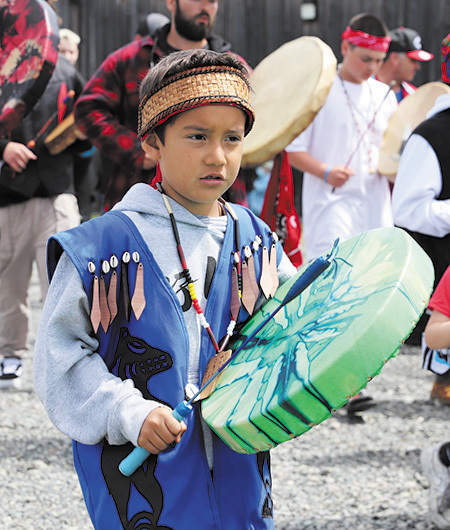
Ten songs and blessings are offered at the Salmon Ceremony and they are performed in the following order:
- The Welcome Song
- Sduhubš War Song
- Eagle/Owl Song (Tribute to Kai Kai)
- Blessing of the Fisherman
- Listen to our Prayers
- hikw siyab yubəč
- The Happy Song
- Table Blessing Song
- Canoe Song (Kenny Moses Jr.’s Song)
- New Beginnings Cleansing Song (Glen’s Song)
Halfway through this year’s ceremony, everything came to a sudden halt when Jaxson Gobin, a young Tulalip tribal member, ran into the longhouse after the blessing of the fisherman and the prayer song ended. Bearing good news, Jaxson informed the people of the arrival of a special guest.
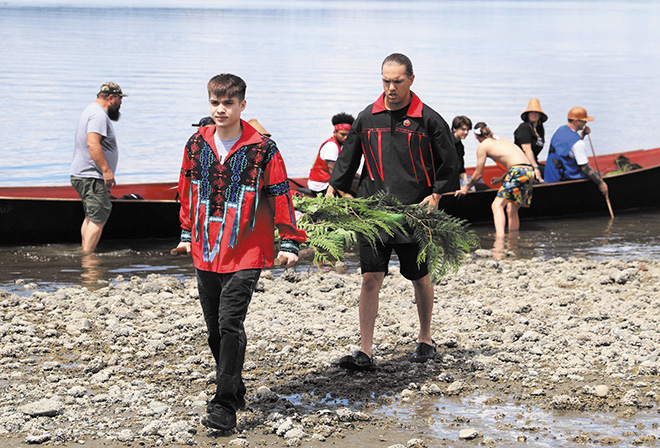
Said Jaxson, “When we sing the prayer song, my grandpa gives me the signal – when to go out. And he tells me when to come back in, which is at the end of the song. Then I yell, the canoe is coming, but isn’t touching the shore yet, with big chief king salmon.”
Hearing of the scout’s arrival at Tulalip Bay, the tribe then began singing hikw siyab yubəč, as they filed out of the longhouse to greet the first king salmon of the 2022 fishing season.
“hikw siyab yubəč is one of the primary Salmon Ceremony songs,” explained Glen Gobin, the Tribe’s official Salmon Ceremony Leader. “We sing this all the way down to the beach once yubəč is here. We sing this to greet our visitor. Once the canoe has landed, and he’s unloaded, he now leads the way. From this point for the rest of the ceremony, he’s at the front, nobody goes in front of him. We sing this all the way to the longhouse and then again when we take him back to the water. We recognize him, give thanks. He is the scout, he comes to see how well we are doing and if we treat him correctly, he’ll tell his people that the Tulalip’s are good people.”
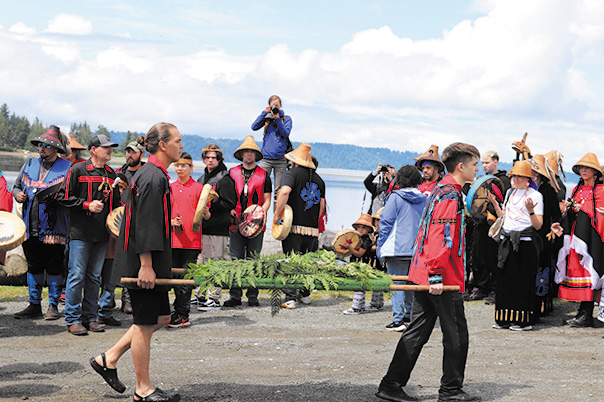
The guest of honor was escorted to the longhouse on a bed of cedar branches and given a tour of where the ceremony takes place, before he was prepared to be shared amongst the entire community together.
The singers, dancers, and witnesses journeyed from the longhouse to the Greg Williams Court, following behind yubəč. Once everybody found their seat, the Tribe performed the Table Blessing Song, a song that has been passed down through thousands of years, as told by Glen. Then they all took their first bite of salmon together, followed by a drink of cool water.
“This first piece is representative of us all sharing the blessing of the yubəč,” said Glen as he addressed the participants in the gym. “I ask that we all eat this piece at the same time together. Now, I’m going to ask that we all take our water and drink it together. This clear water represents the purity of life, and the lifegiving waters in which the salmon come from. Now I’m going to ask that we all eat this wonderful meal together.”
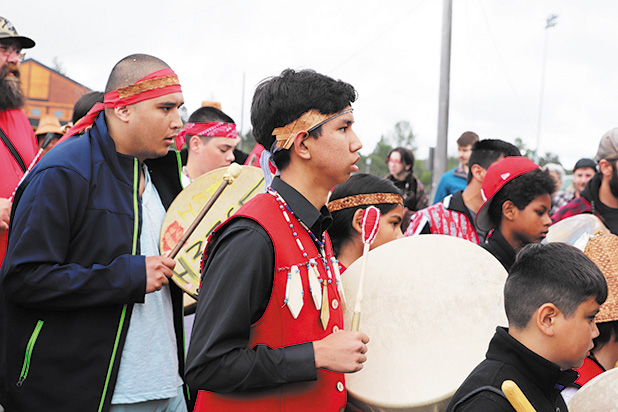
Following the meal, the people brought yubəč’s remains down to the canoe and he was sent back to the Salish Sea to start his journey back to his village, so he could tell the Salmon People how well he was treated by the people of Tulalip. In return, the salmon will frequent the waters of Tulalip Bay this season, where tribal fisherman can catch and bring them into the tribal community, and they can continue providing delicious sustenance for the sduhubš people as they have since time immemorial.
“Salmon Ceremony is about giving respect to those that come from nature,” Glen reflected. “But it also teaches about giving respect throughout life and honoring those gifts that we get, and respecting our way of life in a good way. Part of that is making sure how we sing the songs, how we conduct ourselves, it teaches how to carry yourself in life. All of the songs have meaning, everything is connected. The songs encourage the people to carry themselves in a good way.”
He continued, “Today was great. The longhouse was full. The floor was extremely full. It’s great to have that problem, to have all the young people circling that floor and still coming through the door. The kids did great. The songs were all together, everything sounded great and everybody looked great. I think the ancestors would be very proud, and are very proud, of the work we are doing.”